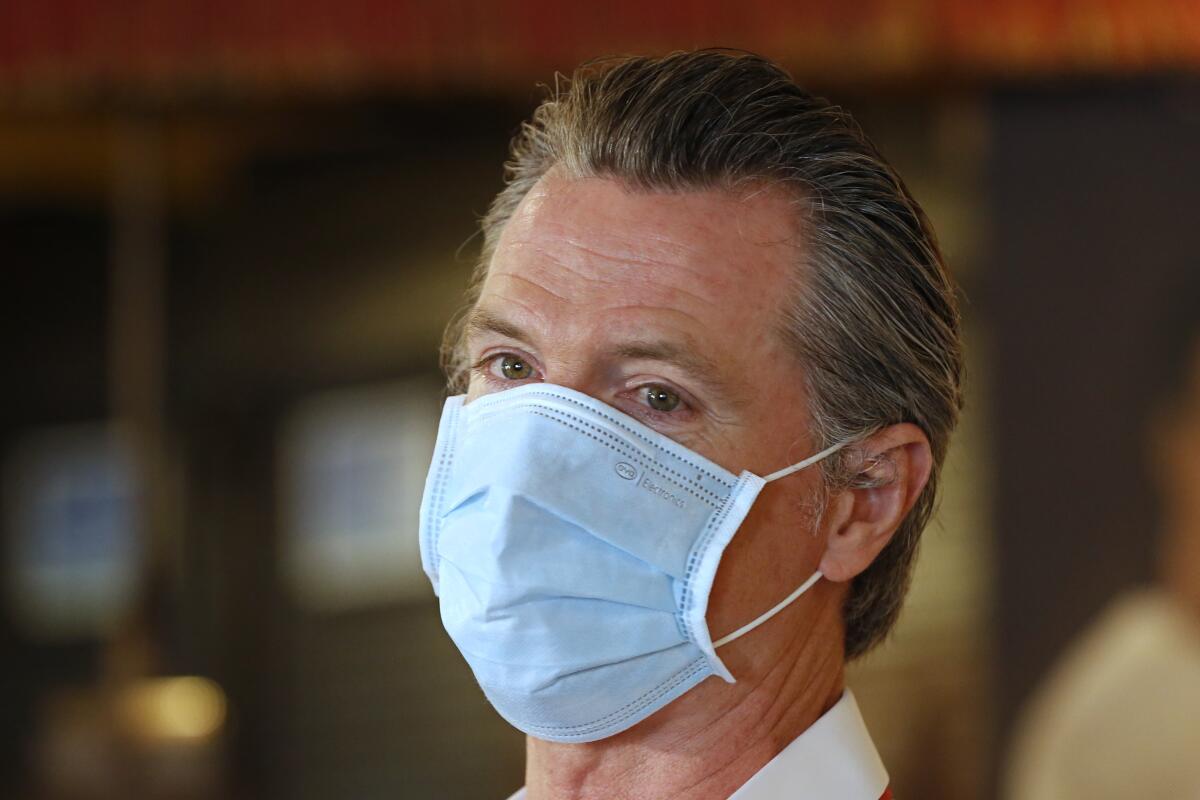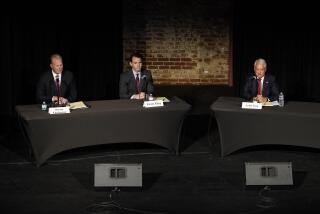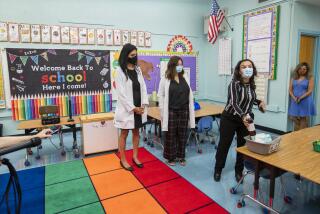News Analysis: As coronavirus surges, new pressure on Gov. Newsom for a schools reopening plan

- Share via
SACRAMENTO — Pressed by reporters to explain why California doesn’t have a statewide rule for when its 6 million schoolchildren can return to their classrooms, Gov. Gavin Newsom insisted Monday that his administration had already offered detailed plans.
“We’ve fortunately done just that, a number of months ago,” Newsom said.
But the plan he appeared to reference, crafted in March, offered support for schools that had decided to close over coronavirus fears — not guidelines noting when to do so. Nor are there any rules in a state Department of Public Health document released last month that focus on school safety tips such as hand washing and physical distancing.
Now, with the number of COVID-19 cases steadily rising across California and less than three weeks to go before some school districts are poised to begin a new academic year, there are no statewide rules laying out the conditions under which schools can, or cannot, open.
It’s a position even some of Newsom’s supporters say is no longer tenable.
“I think the governor’s heart is in the right place,” said Jeff Freitas, president of the California Federation of Teachers, citing Newsom’s reliance on local officials to make choices that fit their communities. “But the burden of making this decision has to rest on his shoulders.”
The California Department of Education’s guide for schools, updated last month, says the decision to open will be made by each of the state’s more than 1,000 school districts. But after the summertime surge in coronavirus cases led to new state-imposed restrictions on businesses and indoor activities, Newsom’s hands-off approach to schools has been puzzling.
“If indoor activity is bad, why allow any — especially indoor classrooms?” state Sen. Steve Glazer (D-Orinda) asked Monday in a Twitter post.
Newsom hinted Monday at soon-to-be-announced limits on school activities but deflected when asked about the lack of a clear statewide standard for in-person attendance.
“He has allowed local agencies to make the decision,” Freitas said. “But I think he needs to change his thinking on this.”
The dilemma over schools has dogged Newsom since the onset of the pandemic. He has often expressed empathy, sharing stories of how his four children suffered from anxiety caused by being away from friends and their school-day routines. As the weeks dragged on, he focused on the state’s need to provide financial help for remote learning and student nutrition — though the state budget he proposed in May in response to the collapse in tax revenue would have slashed school spending by some $15 billion. Legislators rejected the plan, choosing instead to prop up K-12 operations through what amounts to a long-term borrowing plan.
Along the way, the governor has won praise for calling out the need to close the learning gap created by remote schooling for students in California’s poorest families. He has said those issues may continue if kids are not sent back to campus.
But Newsom has consistently refused to create a statewide standard for schools based on metrics similar to those used in his decision this week to throttle back the state’s reopening process and force communities to shutter a variety of services. Instead, he has emphasized that the decision to reopen schools isn’t his to make.
“All of these things need to be managed at the local level with the foundational framework of keeping our kids and our teachers healthy and safe,” he said July 8.
That same day, one of Newsom’s powerful political allies suggested local officials weren’t up to the task.
“The recent surge in the infection rate and the closure of indoor activities in 26 counties gives us pause around the state’s preparedness for safe in-person school instruction in a short six- to eight-week time frame,” wrote leaders of the California Teachers Assn. to Newsom and legislative leaders.
The three-page letter amounted to a vote of no-confidence in local decision making. The association’s leaders demanded “consistent” public health standards and “uniform” protocols.
“Simply said, California cannot reopen schools unless they are safe,” the educators wrote.
As the start of the new school year approaches, tensions have mounted. Parents and teachers have quarreled on social media, clashing over the potential impact of closing or reopening campuses on students with special needs, parents who can’t work from home and teachers afraid of the risks for their own families from increased exposure.
Conflicting local decisions haven’t helped. On Monday, leaders of the Los Angeles Unified School District announced the school year will begin next month with distance learning for all of its 734,000 students. Hours later, the Orange County Board of Education did just the opposite, voting to allow local schools to open classrooms with no requirement that students or staff wear protective masks.
The only obvious difference between the two communities is political. The Times’ coronavirus tracker shows that Orange County has 383 coronavirus cases per 100,000 residents — slightly outpacing L.A. County’s 353 cases per 100,000 residents.
Newsom applauded the leaders of LAUSD and San Diego schools for their decisions to begin the school year with distance learning. But the governor again carefully avoided giving any impression that he was endorsing the choices that were made, saying instead that the schools’ leaders were rightly “recognizing their responsibility at this moment.”
Those with a predisposition to criticize the Democratic governor have pounced. Jessica Millan Patterson, chairwoman of the California Republican Party, jabbed Newsom on Monday by saying that his “lack of direction on opening schools will further harm California’s schoolchildren.”
“His failure to accept responsibility and provide direction to help our state navigate this crisis shows how he clearly is not the leader California needs,” Patterson wrote on social media.
Not all Democratic governors have chosen Newsom’s path. New York Gov. Andrew Cuomo laid out detailed rules Monday for deciding whether schools will open, using average infection rates over a 14-day period as a measuring stick and requiring schools to close their doors if the rates spike too high.
“We are not going to use our children as a litmus test,” Cuomo said during a livestreamed event. “We’re not going to put children in a place where their health is in danger.”
Meanwhile, the Trump administration could demand a statewide standard in exchange for something California has already banked on: a substantial new round of coronavirus relief, totaling at least $14 billion in the state budget Newsom signed last month.
“I think the president would be willing to consider additional funding for state and local governments if the schools do reopen,” Larry Kudlow, the president’s economic advisor, said in an interview on the Fox News Channel.
Some local school districts in California have felt pressure to reopen their campuses, citing language tucked inside the state budget mandating in-person schooling, though members of the Legislature later argued that it would be superseded by a public health order.
But they have also wondered why Newsom isn’t offering a more definitive path forward. Maybe a plan is coming. Or maybe not.
The governor labored over the issue in an exchange with a reporter Monday, jumping back and forth in an answer that lasted more than two minutes. He pointed out the “bottom-up” governance structure of schools but assured he is “well aware of my responsibilities,” while later noting that school districts are “unique and distinctive.”
“The dynamic nature of the spread of this virus,” Newsom said, “means you’ll be hearing a lot more in the next few days, and presumably weeks, as we get closer to the opening of the school year.”
More to Read
Sign up for Essential California
The most important California stories and recommendations in your inbox every morning.
You may occasionally receive promotional content from the Los Angeles Times.











